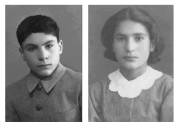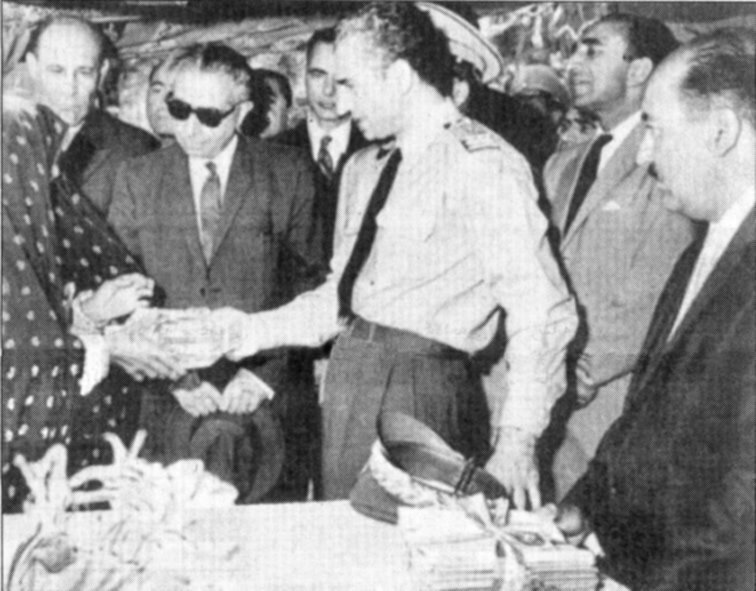Photo
Album
Hamid
Hakimi's Memoires in Persian
A Short Biography Of Abdol-Hamid Hakimi
The second son of Hashem Hashemi <<Moazzem-el-Molk>> and Mah Lagha Hakimi was born on the way to Shiraz near Isfahan on 24th April 1901. He was educated at the Teheran Primary School and then attended Dar-ol-Fonon (Amir Kabir) High School and College. He attended the first School Of Law established by the French in the same college and was one the first graduates from the newly established Iranian higher education system (he was one of nine graduates in the entire country that year, by comparison in academic year 1997-98 a total of 246,437 students graduated from universities and higher education institutes).
He
started life as a teacher then as a career civil servant in the
Ministry of
Education. He soon headed the Development office which is were he
brought much
needed reform, mostly on his own initiative from which the Iranian
youth
benefits to this day (early to mid 1930's).
He introduced standardised free school text books for school children. He oversaw the entire process of printing, publishing and distributing the book across the country. The process he established is still working in Iran after seventy years and benefits all Iranian school children.
Another reform was standard school uniforms using textiles produced in Iran for the first time. Around 1935 he had the uniforms designed and used his son Hashem and daughter Farzaneh to model the uniforms as in the photographs below. He then submitted them for approval by Reza Shah who approved it at once. The supply was awarded to Kazerouni Textile Industries. Since this was very beneficial for the company he persuaded the owners to plough some of their profits back into the education system. He also banned the practice of flogging and the corporal punishment in schools.

He persuaded the acting Minsiter of Education A A Hekmat to introduce English alongside French as a second language arguing that it was an easier language for students to learn. Furthermore he was convinced that it would one day replace French as the de facto international language.
Reza Pahlavi (1877 - 1944) was the shah (king) of Iran at the time. He was forcing through rapid development of Iranian society and infrastructure. When he needed someone to manage the project to establish the medical faculty of Teheran University (the university is globally recognised for its high standards) he chose Abdol-Hamid Hakimi. Although he had no background in either medicine or construction he was chosen for his management ability. He was in essence a trusted trouble shooter for the Shah.
He was moved from Education to the newly formed Ministry of Justice by the minister, A A Davar. Together they worked towards setting up a modern justice structure in Iran for the first time. After Davar became prime minsiter, he came to the view that complete independence of judiciary could not yet become reality and had himself transferred back to Education.
 His
collaboration with Davar extended beyond Ministry of Justice, and they
had
formed a party called the Radical Party and attracted many young
professionals
and Abdol-Hamid became the party secretary. Following the Davar's
unfortunate suicide
members of the Radical Party formed the Society for Young Professionals
to
assist with Reza Shah's rapid development programme for Iran.
His
collaboration with Davar extended beyond Ministry of Justice, and they
had
formed a party called the Radical Party and attracted many young
professionals
and Abdol-Hamid became the party secretary. Following the Davar's
unfortunate suicide
members of the Radical Party formed the Society for Young Professionals
to
assist with Reza Shah's rapid development programme for Iran.
He then moved to the Home Office as the Political Undersecretary. One of his first acts without waiting for the approval of the ministry was to bring an act of Parliament to make it illegal for Iranian women to marry Foreign subjects without the permission of the Home Office (or Ministry of Interior). The main reason for this was to put a stop to white slavery.
Because of his honesty, truthfulness and straightforwardness, it seems that Reza Shah had come to rely on Abdol-Hamid on many occasions to deal with urgent problems. When there was a Cholera epidemic in the southeastern province of Balouchestan, Reza Shah sent him to deal with the epidemic. To investigate smuggling in southern Iran from the Persian Gulf and irregularities in the Iranian Navy there, the Shah again turned to him. During this assignment that he worked with Admiral Bayandor who later became a casualty of the Allied invasion of Iran (a neutral country).

17/1/1938
Reza Shah next appointed him as the head of School of Agriculture based in Karaj. Owing to scarcity of water, efficient agriculture is vital for Iran. As part of a gigantic effort to modernise the country the need for trained agriculturalists and technicians was identified and the Shah again wanted a reliable manager to implement the ideas. Hamid Hakimi established the newly founded college and in the beginning hired Austrian lecturers and specialists to get it underway.
After the invasion of neutral Iran by Allied forces in 1941 he joined the board of Agricultural Bank setup to provide financial assistance for development and modernisation of agriculture in Iran. Assistance was given to farmers to buy tractors and machinery in an effort to mechanise agriculture. He was responsible for construction of the Bank headquarters, the first 10 storey building in Iran designed by built entirely by Iranian engineers and builders.

One of
the first ceremonies of Land Reform in Iran from the right: Minister of
Agriculture
Arsanjani, Assadollah Alam, Mohammad Reza Shah Pahlavi, Ali Amini
Prime Minister, Hamid Hakimi
He was also given the task of managing crown's agricultural properties by Mohammad Reza Shah Pahlavi (alternative biography and album) . The Shah was impressed by his work and appointed him as the Permanent Undersecretary for Department of Agriculture where he initiated the plan for land reform referred to earlier in the family's brief history one of the main reforms introduced by the Shah under his programme of reform called the White Revolution. The project was seen to completion later by Dr Arsanjani. The ministry building in Elizabeh Boulevard in Teheran is again one of Abdol-Hamid's projects.
Adbdol-Hamid has six children from two marriages to Nossrat Taslimi-Moghaddam and Homa Tavakoli. His eldest daughter Farzaneh died before him and his other children are Hashem, Parvaneh, Fataneh, Maryam and Majid. Abdol-Hamid spend his last years in Geneva with his children Majid and Maryam, but returned to Iran and passed away there on 3rd of Septmeber 1997.
Marriage to Nossrat Taslimi-Moghadam
|
|||||
Marriage to Homa Tavakoli